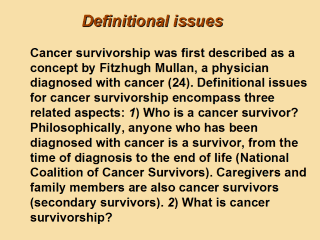| front |1 |2 |3 |4 |5 |6 |7 |8 |9 |10 |11 |12 |13 |14 |15 |16 |17 |18 |19 |20 |21 |22 |23 |24 |25 |26 |27 |28 |29 |30 |31 |review |
 |
Mullan (24)
described the survivorship experience as being similar to the seasons the
year. He recognized three seasons or phases of survival: acute (extending
from diagnosis to the completion of initial treatment, encompassing issues
dominated by treatment and its side effects), extended beginning with the
completion of initial treatment for the primary disease, remission of
disease, or both; dominated by watchful waiting, regular follow-up
examinations and, perhaps, intermittent therapy) and permanent survival (not
a single moment; evolves from extended disease-free survival when the
likelihood of recurrence is sufficiently low). An understanding of these phases of survival is important vis-a`-vis an optimal transition into and management of survivorship. 3) What is cancer survivorship research? Cancer survivorship research seeks to identify and examine adverse cancer diagnosis and treatment-related outcomes (such as late effects of treatment, second cancers and quality of life); provide a knowledge base regarding optimal follow-up care and surveillance of cancer survivors; and optimize health after cancer treatment. |